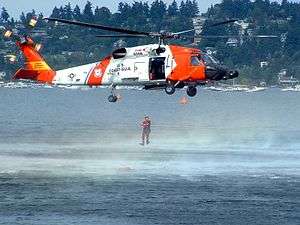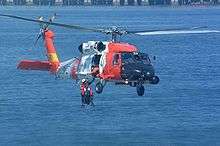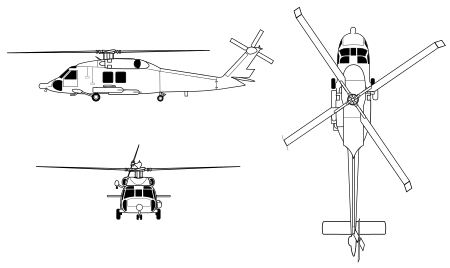Sikorsky MH-60 Jayhawk
| MH-60J / HH-60J Jayhawk | |
|---|---|
 | |
| A HH-60J Jayhawk hovering as a USCG rescue swimmer enters the water during a demonstration. | |
| Role | Medium range recovery helicopter[1] |
| Manufacturer | Sikorsky Aircraft |
| First flight | 8 August 1989 |
| Status | In service |
| Primary user | United States Coast Guard |
| Produced | 1990-1996 |
| Number built | 42 + 3 conversions |
| Unit cost |
US$17 million |
| Developed from | Sikorsky SH-60 Seahawk |
The Sikorsky MH-60T Jayhawk is a multi-mission, twin-engine, medium-range helicopter operated by the United States Coast Guard for search and rescue, law enforcement, military readiness and marine environmental protection missions. Originally designated HH-60J before being upgraded and redesignated beginning in 2007,[2] the MH-60T is designed to fly a crew of four up to 300 mi (483 km) offshore, hoist up to 6 additional people on board while remaining on-scene for up to 45 minutes and return to base while maintaining an adequate fuel reserve. Normal cruising speed of the MH-60T is 135 to 140 kn (155 to 161 mph) and the aircraft is capable of reaching 180 kn (207 mph) for short durations. The MH-60T can fly at 140 kn (161 mph) for six to seven hours.[3]
Chosen to replace the HH-3F Pelican, the MH-60T is a member of the Sikorsky S-70 family of helicopters and is based on the United States Navy's SH-60 Seahawk helicopter.[1] Development began in September 1986, first flight was achieved on 8 August 1989, and the first HH-60J entered USCG service in June 1990. Production ended in 1996 after 42 helicopters were produced; three retired SH-60F Seahawks were also remanufactured to MH-60T specifications beginning in 2010.[4] A total of 42 MH-60Ts are in service with the Coast Guard.[5]
Development
Chosen to replace the HH-3F Pelican, the HH-60J was based on the United States Navy's SH-60 Seahawk and a member of the Sikorsky S-70 helicopter family. Compared to its predecessor, the HH-3F, the HH-60J is lighter, faster, and equipped with more sophisticated electronics and more powerful engines.[1] The HH-60J was developed in conjunction with the U.S. Navy's HH-60H Rescue Hawk.[6]

Sikorsky began development in September 1986 and aircraft registration number 6001 achieved first flight on 8 August 1989. The first aircraft was delivered to the USCG for developmental testing in March, 1990 at NAS Patuxent River, Maryland. In March 1991, ATC Mobile, Alabama became the first USCG unit to fly the HH-60J, allowing instructor pilots to prepare for pilot training. Coast Guard Air Station Elizabeth City, North Carolina was the first USCG operational unit to fly the HH-60J.[1] Sikorsky produced 42 HH-60Js with sequential registration numbers from 6001 through 6042.[7] Sikorsky ceased production in 1996 after fulfilling the 42 unit contract. Subsequently, the Coast Guard has converted three ex-Navy SH-60F Seahawks into MH-60T Jayhawks (registration numbers 6043-6045) as attrition replacements.[4]
MH-60T upgrade program
The USCG began converting its 42 HH-60Js to MH-60Ts in January 2007. This avionics and capabilities upgrade is part of the USCG's Integrated Deepwater System Program and will provide a glass cockpit, an enhanced electro-optic/infrared sensor system as well as a radar sensor system and airborne use of force capability.[8][9] The airborne use of force package includes both weapons for firing warning and disabling shots and armor to protect the aircrew from small arms fire.[2][10] The MH-60T upgrades were completed in February 2014.[11]
Design
With a fuel capacity of 6,460 lb (2,930 kg), the HH-60J is designed to fly a crew of four up to 300 mi (483 km) offshore, hoist up to 6 additional people on board while remaining on-scene for up to 45 minutes and return to base while maintaining an adequate fuel reserve. Normal cruising speed of the HH-60J is 135 kn (155 mph) to 140 kn (161 mph) and the aircraft is capable of reaching 180 kn (207 mph) for short durations. The HH60J can fly at 140 kn (161 mph) for six to seven hours.[3]
The HH-60J uses the NAVSTAR Global Positioning System as its primary long range navigational aid, using a Collins RCVR-3A radio to simultaneously receive information from four of the NAVSTAR system's 18 worldwide satellites.
The HH-60J is normally based on land but can be based on 270 foot medium endurance Coast Guard Cutters (WMEC) or 378 foot high endurance Coast Guard Cutters (WHEC).
The HH-60J has a radar for search/weather that gives its nose a distinctive look. A forward looking infrared (FLIR) sensor turret can be mounted below its nose. It can carry three 120 US gal (454 L) fuel tanks with two on the port side rack and one on the starboard side rack. The starboard side also carries a 600 lbf (2.67 kN) capacity rescue hoist mounted above the door. The hoist has 200 ft (61.0 m) of cable.[6]
Operational history

In 1990, HH-60J Jayhawks began replacing HH-3F Pelican and CH-3E Sea King helicopters in service with the US Coast Guard. HH-60Js perform search and rescue missions, along with other missions such as maritime patrol and drug interdiction.[12] Coast Guard cutters with their HH-60Js and other helicopters performed security and interdiction in the Persian Gulf in 1991 in support of Operation Desert Storm and also in 2003 for Operation Enduring Freedom.[12]
In January 2011, Juneau Mountain Rescue volunteers, working with the Alaska State Troopers and the Coast Guard, rescued an injured hiker on Ripikski Mountain, near Haines. A Coast Guard MH-60 Jayhawk helicopter, dispatched from Sitka, transported the hiker to Bartlett Regional Hospital in Juneau, Alaska.[13]
On 29 October 2012, Jayhawk number 6031 (70-1790) was used during the offshore rescue of the crew of HMS Bounty during Hurricane Sandy.
Variants
- HH-60J
- Medium range recovery helicopter. 42 units delivered to the USCG between 1990 and 1996.
- MH-60T
- Medium range recovery helicopter. 39 surviving HH-60J airframes received upgraded avionics and operational capabilities, including armaments, between 2007 and 2014.[9] Three SH-60Fs were converted to MH-60T specifications as attrition replacements.[4]
Operators

Accidents
As of July 2010, three Jayhawks have been involved in crashes, including two fatal crashes.[15][16][17]
Specifications (HH-60J)

- Most data is for HH-60J. Data for MH-60T is noted below.
Data from USCG HH-60J information,[3] Sikorsky S-70B Seahawk information,[18][19] Globalsecurity.org HH-60J specifications[20]
General characteristics
- Crew: Four (pilot, co-pilot, two flight crew)
- Length: 64 ft 10 in (19.76 m)
- Rotor diameter: 53 ft 8 in (16.36 m)
- Height: 17 ft (5.18 m)
- Empty weight: 14,500 lb (6,580 kg)
- Max. takeoff weight: 21,884 lb (9,926 kg)
- Powerplant: 2 × General Electric T700-GE-401C gas turbines, 1,890 shp (1,410 kW) each
Performance
- Maximum speed: 180 knots (205 mph, 333 km/h)
- Cruise speed: 140 knots (160 mph, 260 km/h)
- Range: 700 nautical miles (802 mi, 1,300 km)
- Service ceiling: 5,000 ft hovering (1,520 m)
Armament
- 1 × 0.308 in (7.62×51mm) M240H medium machine gun in starboard door (MH-60T)[10]
- 1 × 12.7×99mm (.50 BMG) Barrett M82 semi-automatic rifle (MH-60T)[10]
See also
- Related development
- Sikorsky HH-60 Pave Hawk
- Sikorsky S-70
- Sikorsky S-92
- Sikorsky SH-60 Seahawk
- Sikorsky UH-60 Black Hawk
- Aircraft of comparable role, configuration and era
- Related lists
References
- 1 2 "Acquisition Directorate - MH-60T Medium Range Recovery Helicopter". United States Coast Guard. November 2009. Archived from the original (PDF) on 2010-07-07. Retrieved 2010-07-07.
All 42 H-60 aircraft are scheduled to be modernized by 2015
- 1 2 3 Thirteenth Coast Guard District Public Affairs Office (2003-04-21). "Jayhawk - HH-60J Helicopter" (PDF). United States Coast Guard website. United States Coast Guard. Retrieved 2010-07-07.
...carry out the Coast Guard's search and rescue, law enforcement, military readiness and marine environmental protection missions...
- 1 2 3 SH-60F to MH-60T Conversion Process, United States Coast Guard, 4 April 2014
- ↑ MH-60T: Jayhawk. U.S. Coast Guard
- 1 2 Leoni, Ray D. Black Hawk, The Story of a World Class Helicopter, pp. 212-213. American Institute of Aeronautics and Astronautics, 2007. ISBN 978-1-56347-918-2.
- ↑ "Sikorsky HH-60J Jayhawk". Helis.com. Archived from the original on 2010-07-07. Retrieved 2010-07-07.
42 delivered from 1990. 1 written off.
- ↑ "Acquisition Directorate - Medium Range Recovery Helicopter". United States Coast Guard website. United States Coast Guard. Archived from the original on 2010-07-07. Retrieved 2010-07-07.
The MH-60T project will upgrade 42 in-service HH-60J helicopters ...
- 1 2 Aviation Update newsletter. US Coast Guard, January/February 2007.
- 1 2 3 "Acquisition Update: "T" It Up: First Production MH-60T Medium Range Recovery Helicopter Delivered to Coast Guard". United States Coast Guard website. United States Coast Guard. 2009-06-09. Archived from the original on 2010-07-08. Retrieved 2010-07-08.
The AUF package equips the MH-60T with a 7.62mm machine gun for firing warning shots and a .50 caliber long range rifle for precise targeting...
- ↑ Acquisition Update: Final Jayhawk Completes Conversion to MH-60T Model. U.S. Coast Guard, 19 February 2014.
- 1 2 Tomajczyk, Stephen F. Black Hawk, pp. 74-74. MBI, 2003. ISBN 0-7603-1591-4.
- ↑ "Coast Guard Medevacs Injured Hiker From Ripikski Mountain". Coast Guard News. January 6, 2011. Retrieved March 21, 2015.
- ↑ "Office of Aviation Forces (CG-711) "Jayhawk"". uscg.mil. Retrieved 2 February 2013.
- ↑ Freeze, Ken. "Fatal Coast Guard Aircraft Accidents". check-six.com. Check Six. Archived from the original on 2010-07-07. Retrieved 2010-07-07.
Date of incident: 8 December 2004....Aircraft type and Coast Guard tail number: Sikorsky HH-60 Jayhawk, 6020
- ↑ Liesik, Geoff (2010-03-05). "U.S. Coast Guard team to probe Uinta Mountains crash". Deseret News. Salt Lake City, UT: Deseret News Publishing Co. Archived from the original on 2010-07-07. Retrieved 2010-07-07.
The Jayhawk that crashed was one of two returning to North Carolina from Washington state.... It was last heard from just before 10 a.m. Wednesday.
- ↑ Green, Sara Jean (2010-07-07). "3 dead in Coast Guard copter crash off La Push". Seattle Times. Seattle, WA: The Seattle Times Company. Archived from the original on 2010-07-07. Retrieved 2010-07-07.
The MH-60 Jayhawk helicopter crashed around 9:30 a.m. off James Island near the mouth of the Quillayute River at the northwest tip of Washington state.
- ↑ S-70B Seahawk Technical Information, 2001.
- ↑ "S-70B Seahawk Helicopter Technical Information S70-064 1438 3C". Sikorsky Aircraft. January 2008. Archived from the original (PDF) on 2010-07-07. Retrieved 2010-07-07.
- ↑ Pike, John. "HH-60J Jayhawk Specifications". GlobalSecurity.org. Retrieved 2010-07-07.
External links
| Wikimedia Commons has media related to HH-60 Jayhawk. |
- MH-60T on US Coast Guard site
- HH-60J JAYHAWK Helicopter Product Information. Sikorsky Aircraft Corporation
- HH-60 Jayhawk and MH-60T on globalsecurity.org
- U.S. Coast Guard Fielding Armed HH-65Cs, -60Js. Rotor & Wing
- Coast Guard Plans Jayhawk Modernization. VTOL.org